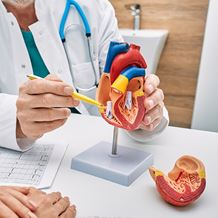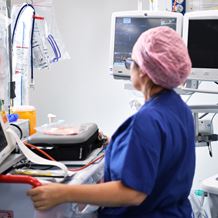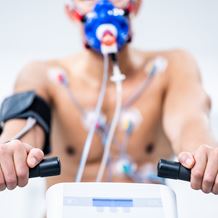What is Cardioversion?
Cardioversion, or external cardioversion, is a medical procedure that is used to restore a normal heart rhythm. It is most often used to treat atrial fibrillation or atrial flutter, the most common types of heart arrythmia which cause an abnormally fast or irregular heartbeat. There are two types of cardioversion treatment available:
- Electric cardioversion – This procedure uses a machine and electrodes to deliver controlled low-energy shocks to the chest, with instant results
- Chemical cardioversion – Medicine is used to restore the rhythm. This can take longer to work and does not involve any type of electric shock.
What does it do?
The aim of cardioversion treatment is to restore a normal heart rhythm. When the heart beats normally, it produces electrical impulses which help the upper (atria) and lower chambers (ventricles) work in a co-ordinated way. Certain heart conditions such as atrial fibrillation and atrial flutter mean that the atria contracts too quickly and the heart cannot work effectively. Chest pain, heart flutters, breathlessness and extreme fatigue are all signs that the heart isn’t pumping enough blood to your body. Cardioversion sends controlled electrical signals to your heart that encourage it to reset the rhythm.
How does it work?
Electrical cardioversion works by sending electrical impulses to your heart in order to shock it back into rhythm. These signals are sent through electrodes that are attached to your chest. It is usually a quick procedure as the heart normally responds immediately. Sometimes the heart may take longer to respond, and the rhythm could return some days or weeks later. Chemical cardioversion works by using medicine to retore the rhythm. The medication works by relaxing your heart muscle and reducing the strain on your heart, as well as slowing down the electrical signals that tell your heart when to beat.
Why is it performed?
If your heart condition is not responding to medication, your doctor may recommend cardioversion as a way to reset the heart rhythm. It is commonly used to treat heart disorders such as atrial fibrillation and atrial flutter, where the electrical signals are not travelling properly through the upper chambers of the heart.
Procedure
Patients are given a type of anaesthetic so that the procedure is entirely pain free and you are asleep throughout. Electrodes are placed on your chest and connected back to a defibrillator machine that will send out the electric shocks. The machine will also monitor your heart activity throughout the procedure. One or more low-energy electric currents are sent to your heart to shock it back into rhythm. You will be monitored for several hours after the procedure to assess your heart and check for any side effects. Chemical cardioversion is usually done in a hospital using oral medication.
Recovery
After your procedure, you are likely to be able to return home the same day and should be able to return to normal activities within a few days. If the condition returns, cardioversion can be repeated, or your doctor may consider another treatment pathway.
What's next?
If you have been experiencing heart-related symptoms, book an appointment with our cardiac services specialist today.
Our specialists in Cardiac Services
View all specialists






